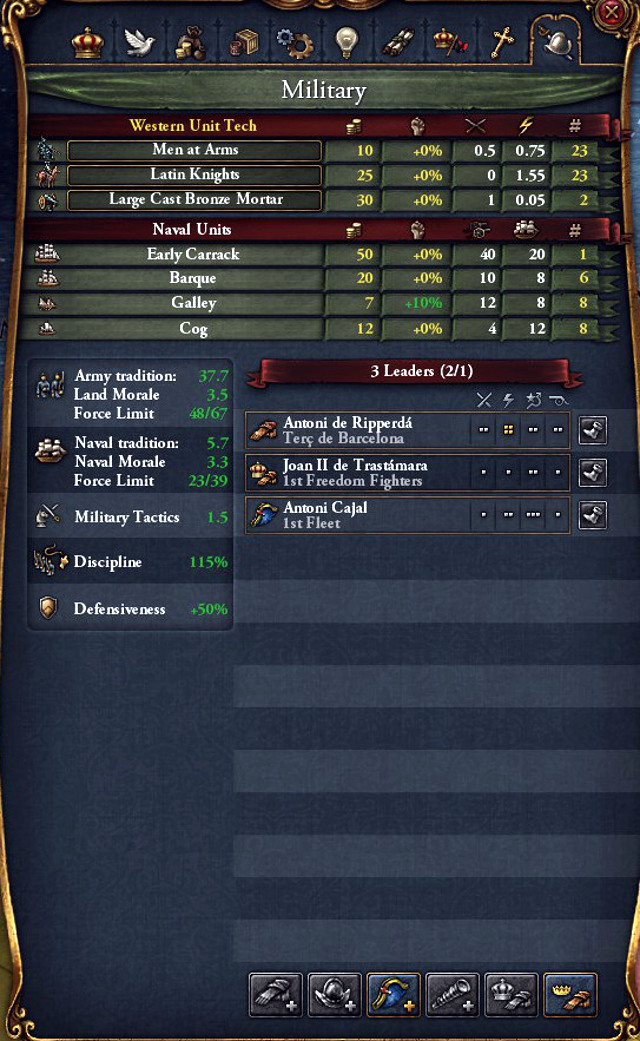Europa Universalis 4: The basics of war

War is the quintessence of EUIV so, everyone who wants to succeed in it, needs to know the rules. War can be divided into land and naval, although the latter is less important and it is on land that the fate of kingdoms kings and countries will be decided. In general, it is easier to defend than to attack but an utter power will, as a rule of thumb, be always decisive. Just like in the case of administration, it pays off to know several basic terms and factors that decide about victory and failure, as well as their impact on the rest of the country.
Manpower
Manpower is the basic factor to how many soldiers you can conscript and how fast it will be possible to replenish losses of the existing units. In a nutshell, if any of the sides depletes its manpower, it will practically lose, unless it can invest in mercenaries. The base regeneration rate for the depleted Manpower is 10 years, while you will be at the mercy of your neighbors. The speed of replenishing manpower can be modified with decisions, ideas, buildings and advisors.
When it comes to the units that already exist, you need to remember that it is going to take longer abroad and that leaders of high maneuver will speed up the process.
Leaders
No army can exist without its commander. Well, it can, in theory but, when it comes to battles, it is better if your army has an experienced general to command it. The cost of a leader is 50 MMP for a general and 50 DMP for an admiral. If you have unlocked Conquest for the New World, you can also employ conquistadors and explorers, who can enter the unknown lands. There is a preset limit on how many leaders you can have and exceeding this limit will cost you 1 military point a month, per each excess leader. If you want to, you can also transform your king, or his heir, into a leader, because they are for free, but you need to take into account the fact that they will be exposed to the risk of dying...or they will have the opportunity to die, if you want the heir to take over from his inept father, or if you want to get rid of an incompetent heir before he ascends to the throne.
Leaders are assessed in accordance with four categories:
- Fire - the phase of the battle in which both sides fire at each other at a distance. Each additional point adds +1 to die roll in this phase;
- Shock - the phase of the battle in which the armies cross their swords. Each additional point adds +1 to die roll in this phase;
- Maneuver - determines the speed of the army on the map, the pace at which losses are replenished and the flanking range of units in the battle . each point decreases wear by 1% and, in the case of admirals, it increases trade power that they generate from protection of trade routes.
- Siege - Each additional point adds +1 to die roll during siege.
Morale, discipline and tactic
The effectiveness of armies' strength in the battle can be modified through discipline, military tactics, tradition and morale. The first two factors are easy and obvious. Simply, the more of them you have, the stronger you hit and the less damage you take. Tradition and morale, basically, work similar but their function is a bit more complicated.
Tradition influences morale, manpower and trade steering. It is amassed through ideas, events discoveries, trade protection and, above all, battles. This does not matter if a battle was victorious or lost, each increases military tradition, to the maximum of 100%, which yields the following effects:
- +0,5 morale
- +50% manpower regeneration speed
- +10% morale regeneration speed
- +100% trade steering (only in the case of naval tradition)
The annual drop to tradition is 5% of the current value. You can decrease this to 2% through the Innovative idea group.
Morale is, to all intents and purposes, the factor of victory and loss in battles. The army, whose morale is first to reach zero, retreats and loses. You should never attack with an army whose morale is low. Morale of an exhausted army regenerates automatically during rest from fight and that is why it is important to swap armies skillfully, so that the freshest ones fight.
Additionally, a low morale can cause two other effects:
Shattering - the army that lost the battle, due to the drop in morale, starts an abrupt retreat into safe regions, far away from the enemy, best to the fortified provinces where supplies are high. It is one of major changes to battle in EUIV. The defeated army does not retreat to the neighboring province, but rather as far as possible, sometimes several provinces across. The area that they flee too is selected automatically and you cannot change their route until they reach their destination.
Disorganization - even after winning a battle, the army's morale may be so low that they will be disorganized. This is signified by a small icon of fire next to the morale bar. They cannot set out and will be stationed in one spot as long as they are disorganized, i.e. as long as their morale is regenerated to the appropriate level.
The maximum level of morale available for an army can be increased through ideas, prestige, technology, advisors, military tradition, piety, in the case of Islam and by holding the title of the Defender of Faith.
Wear
Each land province has a predetermined limit on supplies, which determines the limit of troops that can be stationed there. If there are more troops than the current limit allows, the troops will suffer from wear, which decreases their numbers every month due to desertion, starvation etc. In general, the level of supplies in EUIV is discernibly higher than in the previous installments, so you can have larger armies at your disposal without fear of that much wear but, naturally, it is still an important factor that you need to pay attention to. The level of supplies depends on an individual province, technology level, the leader (maneuver), control exercised over the province (increases the limit by 25%), climate and weather. You should pay most attention to the last factor. In winter, depending on the severity, the limit can be lower by as much as 30%, which may prove lethal for your troops. You should always consider the current conditions while planning on a new campaign. If you are going to attack countries like Russia, you should start your war around March or April to minimize the possibility of operating in winter.
Wear is somewhat different in the case of the navy. A ship near home ports will sufer no wear. After leaving territorial waters, it encroaches the range of supply ships. When you roll your mouse over water, you will notice the distance of the given region from the nearest port and your current maximum range. As long as ships are within range, they will suffer no wear. After you set out further, the process of wearing will start and the level will be rising by 1 each month. The navy will losing a percent of the whole each month, which can, in effect, destroy all ships if they do not make it to the waters that you are capable of supplying, in time. The wear for the months spent at sea will be regenerated after you reach the 22nd level of diplomacy. You should also consider the fact computer's ships are not subject to wear so, you should not be surprised if a fleet makes it around the Americas and attacks on the Western coast of the modern USA.
War Exhaustion
War exhaustion rises as a result of prolonging war. This factor is facilitated, in particular, by defeats, blocked harbors, wear and war taxes. Exhaustion disappears automatically during peacetime but, the base value is only 0.10 per month. You can speed up this process by holding the title of the Defender of Faith and through ideas. You can also decrease exhaustion manually by two, in exchange for 75 diplomacy points. You should avoid long wars and try to finish your actions relatively quickly. High war exhaustion has adverse effect on the entire country. With the maximum of 20 points, these are:
- Diplomatic annexation-1;
- Local revolt risk +20;
- Land and navy morale -0,80
- Manpower regeneration speed-20%
- Units and ships construction time +200%
- Fort defense -40%
- Cost to create core+60%
You are not permitted to copy any image, text or info from this page. This site is not associated with and/or endorsed by the developers and the publishers. All logos and images are copyrighted by their respective owners.
Copyright © 2000 - 2025 Webedia Polska SA for gamepressure.com, unofficial game guides, walkthroughs, secrets, game tips, maps & strategies for top games.
